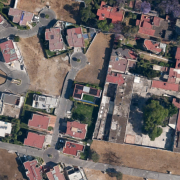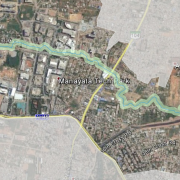Ecosystem Services and Costa Rican Coffee
By Sean Kennedy, Urban Planning PhD student, who traveled to Costa Rica
Last week – through the generous support of the Luskin School of Public Affairs and UCLA Department of Urban Planning – I was fortunate enough to attend the 7th Annual Ecosystem Services Partnership Conference in San Jose, Costa Rica. The week-long conference attracted researchers, practitioners, policymakers and others involved in environmental management and agriculture from institutions, organizations and governments around the world. The conference organizers aim to attract a diverse range of stakeholders representing the different fields and locations that comprise the ecosystem services community, and to do so shift the location of the conference location to a different continent each year. Last year’s conference was held in Bali, Indonesia, and attracted a number of practitioners and researchers from Southeast Asia and Australia. This year’s conference in Costa Rica saw much stronger representation from the Americas, including yours truly.
So what’s all this about ‘ecosystem services’? The concept of ecosystem services (ES) emerged in the 1980s, gained wider recognition in the 1990s, and formed the basis of the Millennium Ecosystem Assessment conducted in the early 2000’s. Since then, the ES approach has filtered through all levels of environmental policymaking across a range of contexts in Global South and the Global North. The concept is grounded in the recognition that human wellbeing is dependent on the services provided by ecosystems. These services include the provision of oxygen, drinking water and timber, regulation of climate and watershed functions, support for agriculture in terms of soil quality, and the cultural ‘services’ different communities derive through their experience of nature and the environment. Under the ecosystem services approach, environmental degradation is attributed to a failure by land users and policymakers to recognize the true value of ecosystem services to human wellbeing. The ES concept thus serves as a basis for the valuation (often in economic terms) of ecosystem services in order to make their true value visible to land users and policymakers, thereby encouraging more sustainable land use practices and policies (or in econ jargon, to internalize hidden externalities, which may be both positive or negative).
The conference involved a wide range of presentations and workshops focused on topics such as ES valuation, ES mapping and modelling, ES and indigenous rights, ES in rural and agricultural areas, and ES in particular biomes and regions, including urban areas. I presented my work on the politics of natural rubber eco-certification (think organic latex mattresses) in a session entitled “Looking beyond Payments for Ecosystem Services: Co-investment and institutional alternatives for ecosystem services provision at the landscape level”. The full-day session featured researchers from Costa Rica, Japan, Venezuela, Brazil, Germany, France, Indonesia and the US. As the catchy title suggests, the aim of the session was to explore options for moving beyond traditional ES policy approaches that have sought to encourage sustainable land use primarily through financial payments to land users. The session emphasized consideration of the social, political and institutional factors – in addition to economic factors – that serve to promote or inhibit the use of financial incentives to promote sustainable land use practices. Presentations focused on the politics of market-based environmental regulations, tenure conflict, tensions between local, regional and national environmental governance, and the contested nature of ecosystem and ecosystem service valuation. The diversity of presentations highlighted the social, political and cultural complexities that characterize many of the efforts to address environmental degradation through the use of financial payments, and showed promise for novel approaches to environmental management grounded in an awareness of context, marking a welcome departure from the blind belief in the magic of the market that has characterized much of the work in the field to date.
As part of the conference I also had the opportunity to attend a field trip to an active payment for ecosystem services (PES) project. The PES project is situated on private land within a productive timber plantation. Under an agreement with the national government and through assistance provided by Costa Rica-based NGO FUNDECOR, the owner has set aside a portion of the plantation to remain idle and to generate secondary forest. Through a government payment program operated by, the land owner receives $64 per hectare of land that he doesn’t touch. While I do not recall the exact size of this particular project (somewhere around 50-100 hectares, or 25-50 American football fields ), FUNDECOR gives technical assistance to nearly 620 owners of forest in Costa Rica’s Central Volcanic Range for the sustainable management of some 42,000 hectares. The payment – although quite small – is administered throughout the year, and serves to provide a level of income stability not afforded by the highly seasonal nature of the timber plantation industry. Not being trained in ecology, it was difficult for me to determine the ecological benefits of this initiative, although from an amateur standpoint it appeared that considerable forest recovery had occurred, and the frogs and birds and various bugs crawling up my pants indicated some level of biodiversity, or at least a higher level than could be found in the neighbouring timber plantation. However, given that the project at this point in time is entirely dependent on government support, the long-term viability of the approach remains in question.
The field trip also involved a visit to an industrial coffee plantation, processing and roasting facility. Costa Rica is famous for its coffee, and the bus drive to the plantations wove through large areas of former forest now dedicated to the production of the world’s most popular drug. While the majority of coffee is still produced in open monocultures, growing awareness of the benefits of inter-planting coffee bushes with taller legumes is promoting a shift towards “shade-grown” coffee. This approach incorporates principles of natural ecology to promote natural ecological relationships, allowing for a multifunctional landscape that in addition to producing coffee is less reliant on external fertilizer, minimizes soil erosion and provides valuable habitat for migratory birds. The plantation we visited has adopted the shade-grown approach, although interestingly this shift was based on primarily for economic rather than environmental reasons: turns out it’s cheaper to plant legumes than to buy chemical fertilizer when you don’t dish out massive subsidies to the agro-chemical industry. The plantation and processing facility produce and distribute coffee to local markets, and also produce speciality coffee for the likes of Intelligentsia and other beard-loving, fixie-riding coffee connoisseurs.
In sum, the conference provided a great opportunity to build networks with representatives of organizations operating at a range of scales, from small grassroots NGOs through to transnational research consortia such as the CGIAR (Consultative Group on International Agricultural Research) and the Food and Agriculture Organization of the UN. The opportunity to hear presentations and present my own research, to interact with researchers from around the world and to experience emerging forms of environmental management first-hand provided a level of insight that would be most difficult to achieve in Westwood. I’m brimming with ideas for my future PhD research. But first, I need a coffee.















